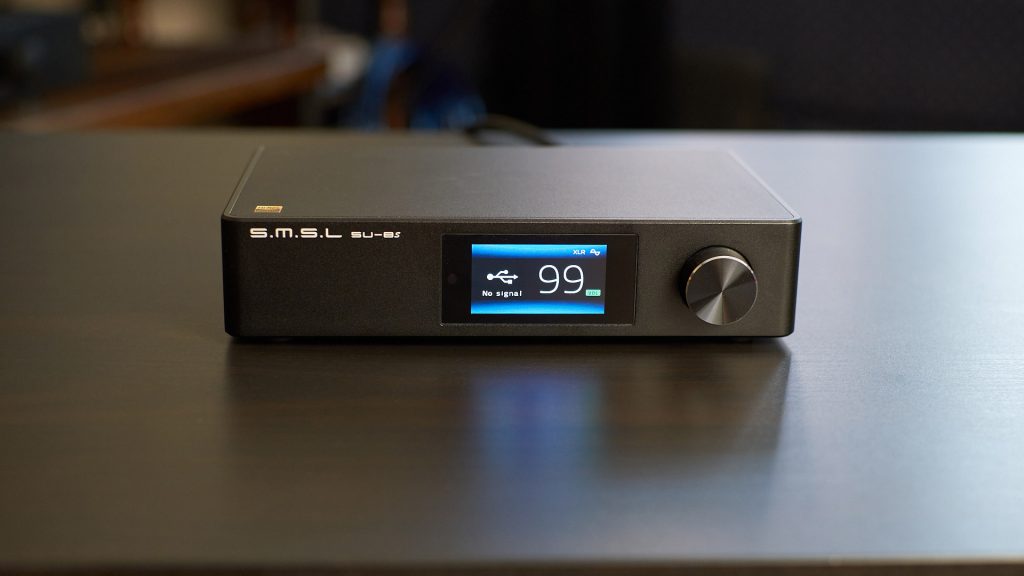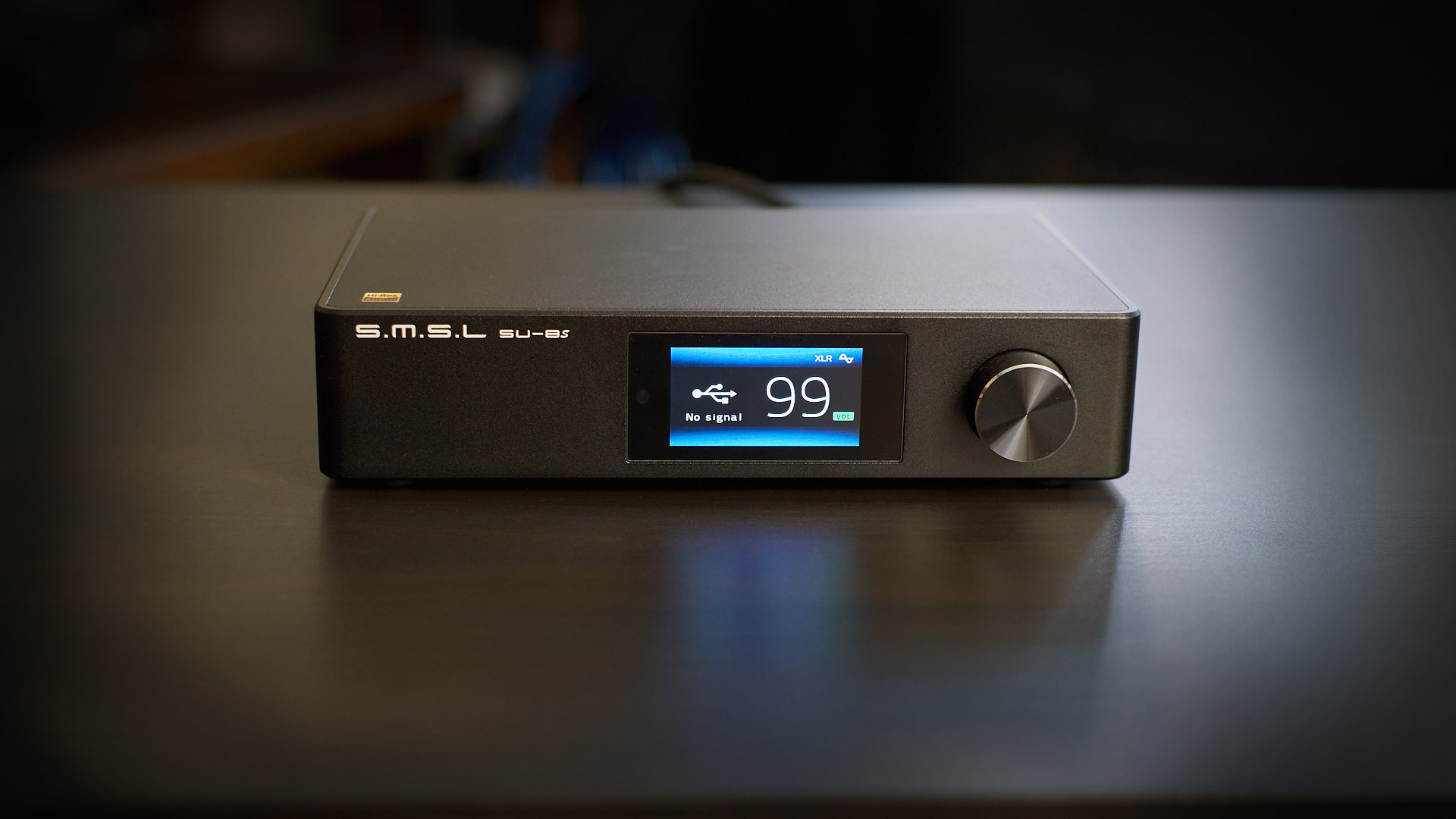SMSL is becoming well known for the affordable DACs with great value and SU-8s tries not to be an exception. The asking price of 349 USD is located in the middle of the SMSL DAC offering, just a small step below their previously released SU-9. Even though the price is shaved by one hundred dollars, SU-8s still brings many interesting features. Hopefully, these features will lead to good performance, but that’s what we aim to determine today, so let us begin.
Build and Connectivity
SMSL SU-8s looked from the outside resembles a lot to its older and slightly more expensive sibling SU-9. It’s completely made of aluminum, uses a color LCD in the front, the same volume knob, and the remote. On the back, things again look very familiar with USB, optical, and coaxial digital inputs. Bluetooth 5.0 connectivity is on-board again too, supporting aptX, aptX HD, SBC, and AAC formats. When it comes to outputs, we can choose between single-ended RCA or balanced XLR ones.

Features and Tech
Looking at the spec sheet we finally find some differences. Namely, SU-8s uses ESS ES9068AS DAC chip instead of the ES9038PRO found in SU-9. That doesn’t affect its great format support that includes PCM all the way up to 768 kHz, DSD up to 512, and even a controversial MQA compression unfolding is fully hardware supported (for the ones that are not familiar with it, MQA is basically a lossy compression aimed at reducing the hi-res file size. All manufacturers have to pay royalties to use it and it doesn’t sound as good as uncompressed hi-res files. Tidal streaming service is the biggest proponent of such compression).
Inside the menu, you can choose one of three PCM filters on offer, then choose one of different tone colors (standard, rich 1, 2, 3, tube 1, 2, 3, crystal 1, 2, 3), and even adjust the level of DPLL level of de-jitter. Since there are too many variations that will slightly affect the sound signature, I will not go through all of them. I personally preferred PCM slow minimum filter, sound color Rich 1, and DPLL at its minimum level, but you should definitely play for yourself and find the ones that suit your taste and the rest of your system best.
To add the last touch, SMSL lets you choose the display brightness and enable the auto-off function. You’ll even be allowed to choose after how many seconds of inactivity the display shall turn off. Small touches like these can make or break the experience of using a product daily when the novelty wears off, and for this kind of attention to detail, SMSL deserves the highest praises.
Sound
But how does the SU-8s actually sounds is the most important question I suppose. To put it shortly, it sounds very good considering its price. A trained ear will quickly recognize that quick and sharp Sabre sound signature. Highs are bright and airy, mid-range is clean and informative, emphasizing crisp edges and transients. That leaves us with the bassline that’s quick and nimble, but somewhat restrained with the default linear filter, but opt for a slow minimum or minimum phase one and it starts sounding weightier, softening some transients in the process. The same is true if you opt for some of the Rich or Tube sound color filters. All of this is important since you can actually tilt the overall sound signature from fast and analytical by default to a somewhat fuller and softer presentation if you wish to do so.
Moving away from the tonality itself, SU-8s has a lot to show when it comes to micro-dynamics. Edges are energetic and transients are quick, making for both revealing and exciting presentation. When it comes to the soundstage, SMSL SU-8s renders a somewhat forward and upfront sound scene, meaning there is not much depth to talk about. That said, the soundstage is sufficiently wide, tall, and offers plenty of air. Instruments are well separated and masterfully etched in their own place.
All in all, SMSL SU-8s is a capable sounding DAC without any doubt, but the real test is to face it against some closest competition and access its true worth.

Comparisons
Topping D30 pro is a direct competitor when it comes to pricing and market positioning. Topping’s contender provides a somewhat warmer bassline and the midbass section, with a more laid-back presentation. It presents edges in a softer fashion, but ultimately reveals a respectable amount of the inner tone texture. SU-8s on the other hand has more upfront presentation, with more energetic edges, quicker and crisper transients. In the upper registers, the D30 pro has a bit grainier and more textured sound to it, while SU-8s sounds cleaner but with more glare and brightness. Choosing between these two finally proved very difficult and depending on your preferences and the rest of the system each one can end up as the preferred one.
To sum it up really quick, I suppose that all of you looking for dynamics, clarity, and excitement before anything else might prefer SU-8s, while the ones appreciating more laid-back, fuller, and softer presentation could lean towards D30 pro more.
SMSL SU-9 has been mentioned throughout this whole review due to the striking resemblance of these models. It carries a 100 USD higher price tag and it comes with the best DAC chip that Sabre produces. That said, the differences in sound fidelity are not that big. Now have in mind that I didn’t have a chance to compare these two directly, but given that I’ve tested SU-9 recently, I’ll give my best shot to make this comparison as I’m sure it will interest most readers. SU-9 offers a somewhat punchier sound if my memory serves well, and that is especially true for the bass region. I remember it hitting with more intent and force. The same is true for the transients that felt somewhat faster on SU-9. That said, I feel that SU-8s is somewhat airer sounding and that its flatter bassline is probably more neutral. To be perfectly honest here, I would be much more comfortable making any definite statements if I could compare them head to head. But either way, both carry a similar, lively, sound signature and you can’t go wrong either way. In my opinion, SU-8s is probably a better value among the two, but SU-9 is still a great offer, especially if you value that extra punch and oomph in the bass region.
Conclusion
SMSL SU-8s is yet another product coming from the SMSL that is quite easy to recommend. Its upfront and somewhat snappy sound signature mean you have to be on board with its character and take a little bit of care not to pair it with similarly zesty-sounding gear because you probably wouldn’t want to emphasize it even more. On the other hand, it’s well built, feature-rich, lively-sounding DAC that has no real faults given its relatively modest price tag. In other words, this is an extremely great value product that’s quite easy to recommend.
| SMSL SU-8s – CHARACTERISTICS |
|
DAC chip: ES9068AS |






Well, that “sharp Sabre sound signature” is what might be a deal breaker for systems with certain “sharp” speakers. I wonder how different are ESS PRO and Rhom chips used in the similarly-priced units: SU-9 and D300 would be a very timely shootout now.
Would you say this is less harsh or warmer? sound. I think I would like a warmer sound. I’m looking at this DAC the SU-9 and the SU-8S, DO200, LOXJIE D50, LOXJIE D40, M500 MK2, and the VMV D1SE or the SU-9N. I stream music with Tidal and never heard MQA but would like to have.
MQA is not Compression it is not equivalent to MP3 or AAC. At tidal, MQA must be embedded in Flac. And there are also MQA CDs they can be bought on e.g. Amazon and eBay and they are famous artists
MQA is a compression algorithm and a lossy one too. It is much more sophisticated and “smarter” compression than MP3 and AAC which makes it a much higher quality format. Still, it does get rid of some data permanently (that is the definition of lossy) to pack hi-resolution audio data onto a smaller memory footprint than possible with any lossless compression such as FLAC. GoldenSound (https://goldensound.audio/) basically proved it by uploading his own files and downloading them back as MQAs. I would suggest watching that video to everyone.
I’m trying to decide: the su 8s or the su 9….I’m running a Bryston 2 b power amp, & a 4 b pre amp with Wharfedale 9.1 dimond bookshelf speakers. The dac would be connected to a Nad cd player…Any thoughts?